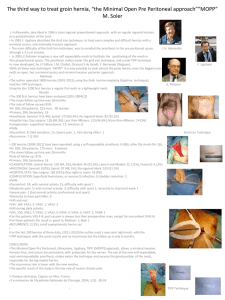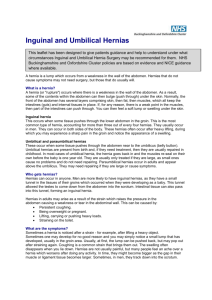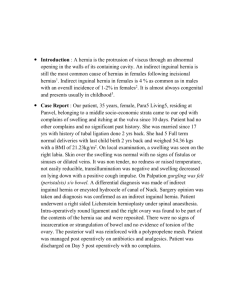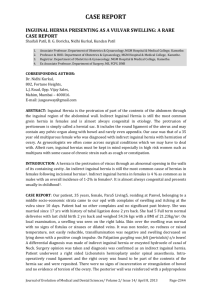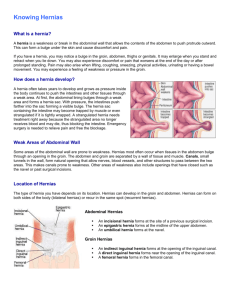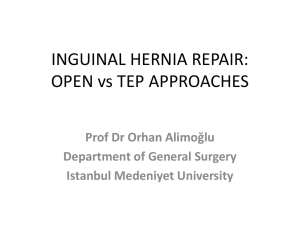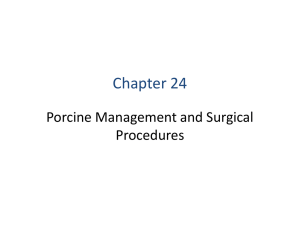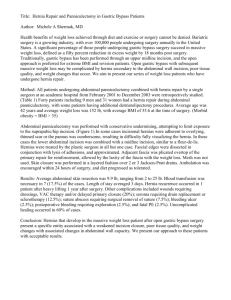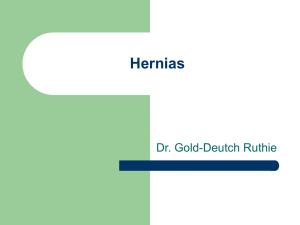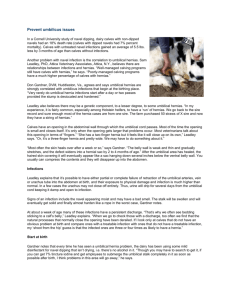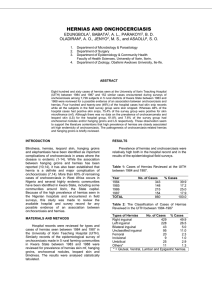Hernias in adults
advertisement
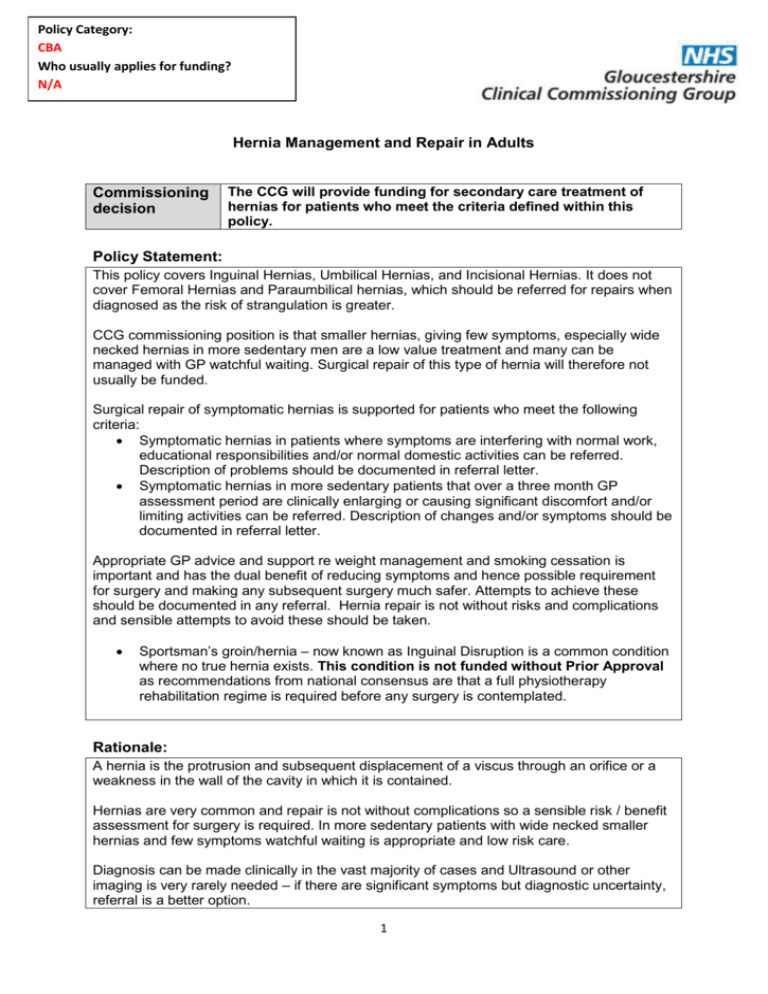
Policy Category: CBA Who usually applies for funding? N/A Hernia Management and Repair in Adults Commissioning decision The CCG will provide funding for secondary care treatment of hernias for patients who meet the criteria defined within this policy. Policy Statement: This policy covers Inguinal Hernias, Umbilical Hernias, and Incisional Hernias. It does not cover Femoral Hernias and Paraumbilical hernias, which should be referred for repairs when diagnosed as the risk of strangulation is greater. CCG commissioning position is that smaller hernias, giving few symptoms, especially wide necked hernias in more sedentary men are a low value treatment and many can be managed with GP watchful waiting. Surgical repair of this type of hernia will therefore not usually be funded. Surgical repair of symptomatic hernias is supported for patients who meet the following criteria: Symptomatic hernias in patients where symptoms are interfering with normal work, educational responsibilities and/or normal domestic activities can be referred. Description of problems should be documented in referral letter. Symptomatic hernias in more sedentary patients that over a three month GP assessment period are clinically enlarging or causing significant discomfort and/or limiting activities can be referred. Description of changes and/or symptoms should be documented in referral letter. Appropriate GP advice and support re weight management and smoking cessation is important and has the dual benefit of reducing symptoms and hence possible requirement for surgery and making any subsequent surgery much safer. Attempts to achieve these should be documented in any referral. Hernia repair is not without risks and complications and sensible attempts to avoid these should be taken. Sportsman’s groin/hernia – now known as Inguinal Disruption is a common condition where no true hernia exists. This condition is not funded without Prior Approval as recommendations from national consensus are that a full physiotherapy rehabilitation regime is required before any surgery is contemplated. Rationale: A hernia is the protrusion and subsequent displacement of a viscus through an orifice or a weakness in the wall of the cavity in which it is contained. Hernias are very common and repair is not without complications so a sensible risk / benefit assessment for surgery is required. In more sedentary patients with wide necked smaller hernias and few symptoms watchful waiting is appropriate and low risk care. Diagnosis can be made clinically in the vast majority of cases and Ultrasound or other imaging is very rarely needed – if there are significant symptoms but diagnostic uncertainty, referral is a better option. 1 Policy Category: CBA Who usually applies for funding? N/A Recurrence rates with modern surgery are low and recurrent non-incisional hernias are more prone to complications so should have a lower threshold for referral. Groin hernias in women are more likely to cause problems and so women should in most cases be referred for assessment. Plain English Summary: A useful printable information leaflet is available at https://www.facs.org/~/media/files/education/patient%20ed/hernrep.ashx A hernia (or 'rupture') occurs where there is a weakness in the wall of the tummy (abdomen). As a result, some of the contents within the abdomen can then push through (bulge) under the skin. Normally, the front of the abdomen has several layers comprising skin, then fat, then muscles, which all keep the guts (intestines) and internal tissues in place. If, for any reason, there is a weak point in the muscles, then part of the intestines can push through. You can then feel a soft lump or swelling under the skin. Different types of hernia can occur. The most common types are: Inguinal hernias – This is the most common type of hernia. Males are more likely to have inguinal hernias, as they have a small tunnel in the tissues of their groins which occurred when they were developing as a baby. This tunnel allowed the testicles (testes) to come down from the tummy (abdomen) into the scrotum. Tissue from the intestines can also pass into this tunnel, forming an inguinal hernia. There are two main types: indirect hernias, which are usually congenital and common in boys, and direct hernias, which are more common in adult men. They can occur in both sides of the body. Femoral hernia – This occurs when some tissue pushes through in the groin, a little lower down than where an inguinal hernia occurs. They occur more commonly in women and tend to be smaller than inguinal hernias. Incisional hernias – This occurs when tissue pushes through a previous scar or wound. They are common if you have had a scar in the past that has not healed well. For example, if the wound had an infection after the operation. They usually occur within two years of having an operation. Umbilical and paraumbilical hernias – These occur when some tissue pushes through the abdomen near to the belly button (umbilicus). Umbilical hernias can be present from birth and in most cases the hernia goes back in and the muscles re-seal on their own before the baby is 1 year old. They will generally be repaired if they persist beyond 5 years of age or if they are very large. Paraumbilical hernias may develop in adults with being overweight (obesity) and excessive accumulation of fluid within the peritoneum of the abdomen. The peritoneum is a lining of the abdomen and consists of two layers, one which lines the abdominal wall and the other which covers the organs in the abdomen. There is good evidence that asymptomatic and mildly symptomatic hernias can be safely managed through a watchful waiting approach, and therefore surgical repair of hernias that are not causing any significant impact on daily activities is not usually funded. Where a hernia is causing symptoms that have a limiting impact on activities, funding for surgical repair will be funded. 2 Policy Category: CBA Who usually applies for funding? N/A Evidence base: http://www.britishherniasociety.org/wp-content/uploads/2013/06/Groin-Hernia-GuidelinesBHS-2013.pdf Fitzgibbons, RJ et al. Watchful waiting vs repair of inguinal hernia in minimally symptomatic men: a randomized control trial. JAMA. 2006 Jan 18;295(3):285-92. http://www.ncbi.nlm.nih.gov/pubmed/16418463 European hernia society guidelines for management of inguinal hernia in adult patients http://www.ncbi.nlm.nih.gov/pmc/articles/PMC2719730/ Complications of hernia repair - http://www.uptodate.com/contents/overview-ofcomplications-of-inguinal-and-femoral-hernia-repair Br J Sports Med doi:10.1136/bjsports-2013-092872 Review of local IFR policies – Bristol, South Gloucestershire, Bath and North East Somerset, Worcestershire, Oxfordshire. All restrict access based on a range of criteria, including level of functional impairment. Link to application form – Not applicable For further information please contact GLCCG.IFR@nhs.net Date of publication Policy review date 1st August 2015 June 2017 Consultation Consultee Planned Care Programme Board CCG Governing Body Development Session GHNHSFT (via General Manager/Head of Contracts) GP Membership (via CCG Live/What’s New This Week) Date 31st March 2015 (virtual) 4th June 2015 18/05/2015 – 29/05/2015 06/05/2015 – 05/06/2015 Has the consultation included patient representatives? No Policy sign off Reviewing Body Effective Clinical Commissioning Policy Group Integrated Governance and Quality Committee 3 Date of review 14th April 2015 18th June 2015
